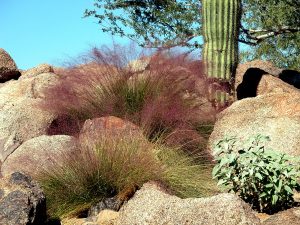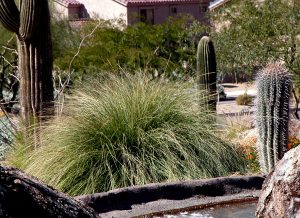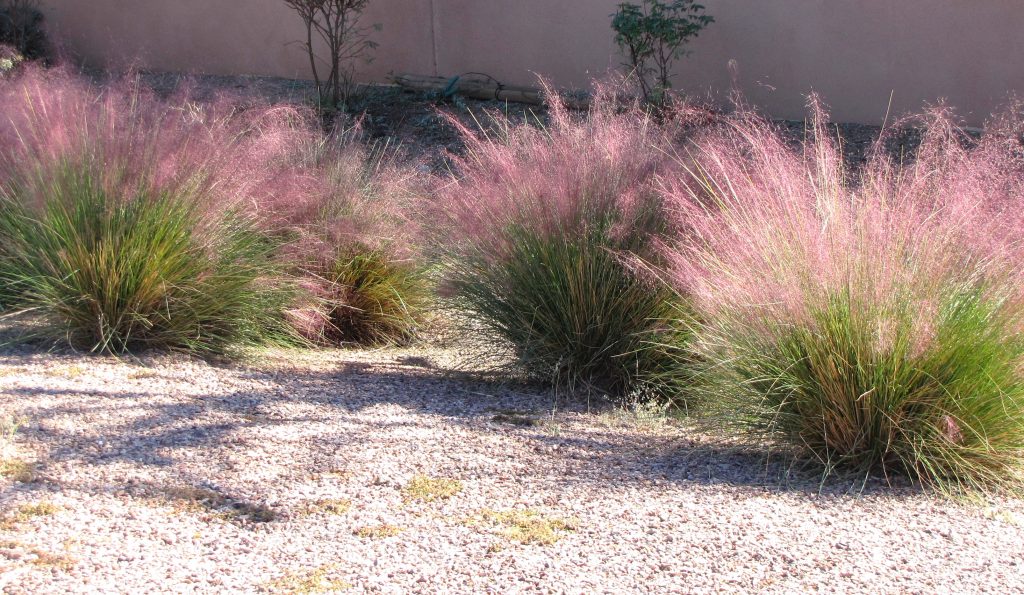These spectacular, non-invasive, ornamental clumping grasses are versatile and require very little maintenance. Muhlenbergias are native to the southwestern United States and northern Mexico at elevations of 2500 to 7000 feet. With over 125 species, this large and diverse group can be used as a vertical specimen or accent, a softening feature around boulders and contrasting dessert plants, or a dense mass that is especially good on slopes for erosion control. The beauty of Muhlenbergias are their whispering foliage that sways in gentle breezes. They provide seeds, cover, and nesting materials for wildlife. The common species range in height from 1 ½ to 5 feet and have a variety of seed head colors, textures and patterns. They bloom from August to November.
Muhlenbergias love full sun but tolerate partial shade, are tolerant of drought, heat, and cold, and can handle most soil conditions including heavy clay, alkaline or salty soils. These perennial grasses survive on rainfall alone, but look better with some supplemental summer watering. They are typically dormant in the winter and look best if trimmed to the ground every two or three years. They have no known pests or problems. We recommend using these grasses in place of the invasive fountain grasses. Here are a couple of the more spectacular species available:
 Muhlenbergia capillaris, Pink Muhly
Muhlenbergia capillaris, Pink Muhly
Pink muhly (a common cultivar name is Regal Mist) has stunning, feathery, rust-colored flowers that rise gracefully up to 2 ½ feet above a 3-foot mound of dark green foliage. This perennial is evergreen in the low desert. After blooming in the fall, gulf muhly becomes semi-dormant in the winter. It can be cut to the ground in February to allow uncluttered, fresh new growth. If planted on the east or west side, the morning or evening sun provides dramatic backlighting. Pink muhly can be used as a border, among boulders, in clusters to create a prairie effect, or as an accent. This species does not reseed, but mature clumps can be divided in the early spring.
Muhlenbergia rigens, Deer Grass
These dense clumps of narrow, bright green leaves grow to 4 feet tall and wide. Deer grass mixes well with boulders in dry creek beds, among subtropical plants, in a meadow, or mini-oasis. Native to the chaparral in the southwest and Mexico, it stays green even without summer water. Deer grass flowers in early fall with slender, leaning, tan flower stalks up to 6 feet tall and then fades to a graceful, fountain-like display of wispy white seed heads that sway in light breezes. Deep grass needs no fertilizer and little water except in low desert summers. Trim back when dormant in winter for best appearance.
Did you know that up to 70% of water use is outdoors? That’s why we love desert plants and feature them each month. It’s still a great time to plant, and you can learn more about Muhlenbergias and other plants on our Arizona Low-Water-Use Plants page. Visit our page on Choosing and Planting Low Water-Use Plants for tips on plant selection and how to plant properly.
This feature is based on a concept and text originally developed jointly by the Arizona Nursery Association and the Arizona Municipal Water Users Association (AMWUA) with partial funding from the Arizona Department of Water Resources. Learn more about these and other great desert plants at the Arizona Municipal Water Users Association Landscape Plants for the Arizona Desert plant database.
Photos in this blog provided by Donna DiFrancesco.


